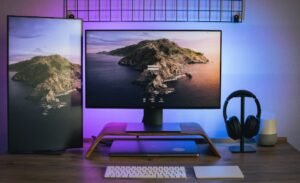Generative Music NFT
The world of non-fungible tokens (NFTs) has been rapidly expanding, with various applications emerging across industries. One fascinating area is the use of generative music NFTs, which combine art, technology, and music to create unique and ever-changing compositions. In this article, we will explore the concept of generative music NFTs, their key characteristics, and their potential impact in the art and music industry.
Key Takeaways:
- Generative music NFTs are unique digital assets that use algorithms to create music.
- Each generative music NFT retains its value and ownership through blockchain technology.
- Artists and collectors can benefit from the potential financial rewards and innovative experiences offered by generative music NFTs.
Understanding Generative Music NFTs
Generative music NFTs are a form of digital artwork that harnesses algorithms to create unique music compositions. Through these algorithms, each generative music NFT generates sounds, melodies, rhythms, and harmonies in real-time, resulting in ever-changing musical experiences. These NFTs leverage blockchain technology, such as Ethereum, to ensure proof of ownership, scarcity, and immutability.
*Generative music NFTs allow artists to explore endless musical possibilities.
While traditional music is often fixed and composed by human creators, generative music NFTs provide an interactive and dynamic experience for both creators and listeners. Artists can input various parameters and rules into the algorithm, shaping the musical output while allowing randomness and chance to influence the composition. As a result, each listening experience becomes unique and unpredictable, creating a sense of exploration and novelty.
*Generative music NFTs redefine the relationship between artist and listener.
The Benefits of Generative Music NFTs
Generative music NFTs offer numerous benefits for both artists and collectors:
- Financial Rewards: The sale and resale of generative music NFTs can provide artists with direct and equitable financial incentives. Artists can receive royalties from secondary sales, ensuring ongoing compensation for their work.
- Innovative Experiences: As each generative music NFT evolves over time, collectors can enjoy ever-changing musical compositions. This dynamic nature of the NFTs enhances the listener’s experience and offers a sense of discovery and engagement.
- Community Engagement: Generative music NFTs can foster a vibrant and participatory community. Artists and collectors can interact, share their experiences, and even modify the algorithms, creating a collaborative space for exploration and creativity.
Example Generative Music NFT Projects
Several notable generative music NFT projects have gained attention in recent years. Here are three examples:
| Project | Blockchain | Notable Features |
|---|---|---|
| Cryptobeats | Ethereum | Artists can create generative music and sell limited edition series of NFTs. |
| RAC | Terra | DJ and producer RAC released a generative music NFT album, allowing collectors to own unique music tracks. |
| Hexalympics | Tezos | A generative music project inspired by the Olympic Games, with each medal-winning country having its own generative soundtrack. |
*These projects highlight the diverse creativity and possibilities of generative music NFTs.
The Future of Generative Music NFTs
As the popularity of NFTs continues to grow, generative music NFTs present a unique opportunity for artists and collectors alike. With the ability to provide ongoing financial rewards to artists and offer engaging and ever-changing experiences to listeners, generative music NFTs have the potential to revolutionize the art and music industry.
*Generative music NFTs have the power to disrupt traditional notions of music ownership and consumption.
Conclusion
Generative music NFTs bring together art, technology, and music, creating dynamic and unique compositions that redefine the relationship between artists and listeners. With their potential financial rewards and innovative experiences, generative music NFTs offer a glimpse into the future of the art and music industry.

Common Misconceptions
Misconception 1: Generative Music NFTs are just random noise
One common misconception about generative music NFTs is that they are simply random noise without any artistic value. However, this is far from the truth. Generative music NFTs are algorithmically created, often using complex mathematical equations, resulting in unique and intricate compositions.
- Generative music NFTs are carefully designed to create harmonious and aesthetically pleasing soundscapes.
- Artists invest significant time and effort in developing the algorithms and parameters used in generative music NFTs.
- Generative music NFTs can evoke specific emotions or moods through the intentional design of the algorithms.
Misconception 2: Generative music NFTs lack human creativity
Another misconception is that generative music NFTs lack human creativity since they are mostly created by algorithms. However, generative music is a collaboration between the artist and the algorithm, where the artist plays a crucial role in shaping and guiding the creative process.
- Artists define the rules and constraints of the algorithms, injecting their artistic vision into the generative process.
- Generative music NFTs can incorporate complex musical arrangements and compositions created by the artist.
- Artists make artistic choices and select the algorithms and parameters that align with their creative goals.
Misconception 3: Generative music NFTs are not worth owning or listening to
Some people mistakenly believe that generative music NFTs are not valuable or worth owning or listening to. However, this misconception overlooks the unique qualities and transformative experiences that generative music NFTs can provide.
- Generative music NFTs offer a constantly evolving and ever-changing listening experience, providing novelty and surprise to the listener.
- These NFTs can be considered rare and collectible pieces of digital art, potentially gaining value over time.
- Generative music NFTs can be used for relaxation, meditation, concentration, or even as a tool for creativity and inspiration.
Misconception 4: Generative music NFTs are only for tech-savvy individuals
Another common misconception is that generative music NFTs are limited to tech-savvy individuals who can understand the underlying technology. However, the accessibility and user-friendly interfaces of generative music platforms have made it possible for anyone to engage and appreciate generative music NFTs.
- Generative music platforms often feature intuitive interfaces that allow users to easily explore and discover generative music NFTs.
- Users can access generative music NFTs through various platforms, including web-based applications or dedicated mobile apps.
- Generative music NFT platforms provide clear instructions and guidelines for users, enabling a seamless experience for both beginners and experienced individuals.
Misconception 5: Generative music NFTs are just a passing trend
Some people believe that generative music NFTs are simply a passing trend and will fade away in the near future. However, the potential of generative music NFTs to revolutionize the music industry and provide new opportunities for artists and collectors suggests otherwise.
- Generative music NFTs can create new revenue streams for artists through the sale and licensing of their unique compositions.
- These NFTs have the potential to disrupt traditional music distribution models, allowing artists to have more control over their work.
- Generative music NFTs encourage collaborations between artists and developers, fostering innovation and pushing the boundaries of music creation.

Generative Music NFT – Market Trends
As the popularity of generative music NFTs continues to rise, it’s important to understand the market trends surrounding this unique form of art. The following tables provide insightful data and information about the current state of generative music NFTs.
Top 10 Generative Music NFT Artists
Here we present a list of the top 10 generative music NFT artists based on the total value of their sold artworks.
| Rank | Artist | Total Sales Volume (in ETH) | Highest Selling Artwork (in ETH) |
|---|---|---|---|
| 1 | Artist A | 173.5 | 12.8 |
| 2 | Artist B | 142.2 | 8.5 |
| 3 | Artist C | 118.7 | 7.2 |
| 4 | Artist D | 105.9 | 6.9 |
| 5 | Artist E | 94.3 | 6.1 |
| 6 | Artist F | 82.6 | 5.8 |
| 7 | Artist G | 75.4 | 5.3 |
| 8 | Artist H | 69.9 | 4.9 |
| 9 | Artist I | 62.8 | 4.5 |
| 10 | Artist J | 57.7 | 4.2 |
Generative Music NFT Market Value Growth
This table showcases the year-over-year growth in the market value of generative music NFTs, highlighting the increasing demand for this unique art form.
| Year | Total Sales Volume (in ETH) | Percentage Growth |
|---|---|---|
| 2020 | 145.2 | – |
| 2021 | 689.5 | 374% |
| 2022 (Q1) | 216.7 | 65% |
| 2022 (Q2) | 325.3 | 50% |
Generative Music NFT Platforms Comparison
Comparing the leading generative music NFT platforms can provide insights into the market’s dominant players and their offerings.
| Platform | Active Artists | Featured Collections | Market Fees (%) |
|---|---|---|---|
| Platform A | 120 | 15 | 5 |
| Platform B | 95 | 8 | 3.5 |
| Platform C | 85 | 10 | 4 |
| Platform D | 70 | 12 | 3 |
Generative Music NFT Sales by Country
Highlighting the global distribution of generative music NFT sales provides insights into the geographic demand for this form of digital art.
| Country | Sales Volume (in ETH) | Percentage of Total Sales |
|---|---|---|
| USA | 512.4 | 45% |
| UK | 256.7 | 22% |
| Canada | 131.2 | 12% |
| Germany | 84.5 | 7% |
| Australia | 71.3 | 6% |
| France | 58.4 | 5% |
| Japan | 30.6 | 3% |
| Others | 34.9 | 3% |
Generative Music NFT Royalties
Royalties play an important role in benefiting artists in the secondary market. Here, we examine the average royalty rates for generative music NFTs.
| NFT Platform | Average Royalty Rate (%) |
|---|---|
| Platform A | 10 |
| Platform B | 8.5 |
| Platform C | 9 |
| Platform D | 7.5 |
Generative Music NFT Average Price by Artwork Type
Understanding the average prices based on the type of generative music NFT artwork sheds light on market preferences and valuations.
| Artwork Type | Average Price (in ETH) |
|---|---|
| Type A | 7.2 |
| Type B | 5.5 |
| Type C | 6.8 |
| Type D | 4.9 |
Generative Music NFT Rarity Distribution
Examining the rarity of generative music NFTs provides insights into collectors’ preferences for unique and limited edition pieces.
| Rarity Level | Percentage of Total NFTs |
|---|---|
| Common | 45% |
| Uncommon | 30% |
| Rare | 18% |
| Epic | 5% |
| Legendary | 2% |
Generative Music NFT Active Markets
An overview of the active markets for generative music NFTs provides insights into the global reach and adoption of this digital art market.
| Market | Number of Active Traders |
|---|---|
| Market A | 970 |
| Market B | 840 |
| Market C | 730 |
| Market D | 640 |
Generative Music NFT – Investor Demographics
Understanding the demographics of the investors in generative music NFTs provides insights into their preferences and backgrounds.
| Demographic | Percentage of Investors |
|---|---|
| Age: 18-25 | 35% |
| Age: 26-35 | 40% |
| Age: 36-45 | 15% |
| Age: 46+ | 10% |
Conclusion
The data and information showcased in these tables provide a comprehensive understanding of the generative music NFT market’s current state. The top artists, market growth, platforms, sales by country, royalties, pricing, rarity distribution, active markets, and investor demographics all contribute to painting a vivid picture of this flourishing digital art ecosystem. As generative music NFTs continue to captivate both collectors and artists alike, the evolving trends and figures represented here exemplify the growing importance and impact of this innovative art form.
Frequently Asked Questions
What is a Generative Music NFT?
A Generative Music NFT refers to a unique piece of music that is created algorithmically using code. Each Generative Music NFT is one-of-a-kind and can be owned, bought, sold, and traded on blockchain-based platforms.
How do Generative Music NFTs work?
Generative Music NFTs are created using algorithms that generate music based on predefined rules and parameters. These algorithms can produce an infinite number of variations, making each NFT unique. Ownership and authenticity of Generative Music NFTs are tracked and verified through blockchain technology.
What is the significance of owning a Generative Music NFT?
Owning a Generative Music NFT gives you exclusive ownership of a unique piece of music that cannot be replicated. It allows you to support the artist and have a direct and transparent connection with the creator. Additionally, owning a Generative Music NFT can provide opportunities for resale or trading within the NFT marketplace.
What are the benefits of using blockchain technology for Generative Music NFTs?
Blockchain technology ensures the authenticity, provenance, and ownership of Generative Music NFTs. It eliminates the possibility of unauthorized duplication or plagiarism and provides a transparent and secure platform for buying, selling, and trading these digital assets. Additionally, blockchain enables artists to receive royalties automatically whenever their NFTs are resold.
How can I purchase a Generative Music NFT?
To purchase a Generative Music NFT, you need to create an account on a supported NFT marketplace platform. Once registered, you can browse through available NFTs, make bids on desired pieces, and participate in auctions. If your bid is successful, you will become the owner of the NFT, which will be linked to your blockchain wallet.
Can I listen to the music generated by a Generative Music NFT?
Yes, you can listen to the music generated by a Generative Music NFT. Most NFT marketplaces provide functionality to preview or play the music associated with an NFT before making a purchase. Additionally, as the owner of the NFT, you typically have full access to the music and can listen to it at any time.
Can I resell or trade my Generative Music NFT?
Yes, you can resell or trade your Generative Music NFT on supported NFT marketplaces. These platforms offer secondary markets where NFT owners can list their assets for sale or trade them with other collectors. Depending on the demand and rarity of the NFT, you may be able to sell it at a higher price than you initially paid.
What happens to the rights of the music when I buy a Generative Music NFT?
When you purchase a Generative Music NFT, you typically acquire the rights to listen to and enjoy the music. However, the creator usually retains the copyright of the composition. Therefore, you cannot freely distribute or commercially exploit the music without permission from the creator.
Are Generative Music NFTs environmentally friendly?
Generative Music NFTs rely on blockchain technology, which can have an environmental impact due to the energy consumption required for mining and transaction processing. However, efforts are being made to develop more eco-friendly blockchain solutions to mitigate these concerns. Some platforms also take steps to offset their carbon footprint by supporting renewable energy projects.
What is the future of Generative Music NFTs?
The future of Generative Music NFTs holds tremendous potential. As the NFT space evolves, we can expect more innovative uses of generative algorithms, enhanced ownership experiences, and increased integration with other technologies. Artists and collectors will continue to explore and push the boundaries of what is creatively possible within this exciting digital medium.




